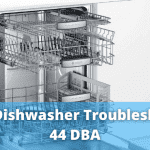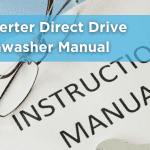Table of Contents
Do you have a dishwasher that’s leaking from the bottom? If the leaky cycle is as consistent and regular as when washing dishes themselves, then we have some bad news for ya!
A leaking dishwasher is both unsightly and potentially dangerous. Fortunately, most dishwasher repairs may be completed at home with a bit of knowledge. We’ll go through 6 common causes of dishwasher leaks and water in the bottom of the machine to assist you in understanding the disaster.
You will learn how to diagnose your problem by identifying what type of leak it is and then find out how to fix it yourself! We’ve got all the information you need right here, so let’s get started!
It is essential to consult the owner’s manual or research your model number online for additional tips and resources. Many major dishwasher manufacturers, including Bosch GE Frigidaire, have terrific consumer-friendly websites packed with helpful information. You can find a local retailer of parts available if needed, but you might also want to chat live one on one!
1. Leaking Door
Is there a water accumulation right beneath the door? A leak in the door is likely to be your problem. Your door latch may be loose or bent or not latching correctly. To ensure that the closure remains secure, tighten the latch with a screwdriver. New latch systems can also be added. If water continues to flow from the door after
This is the rubber gasket that keeps water from pouring out of your dishwasher. If your gasket gets worn down, replacement is simple. Soak the new gasket in warm soapy water to make it more flexible and easier to install. Tighten any loose hinges while you work on the door.
Alert: To ensure your safety and the integrity of any repairs, always disconnect power before performing them. Water can be damaging to electronics, so don’t take risks with wet equipment!
2. Leaking Tub
If your dishwasher’s tub has a hole in it, it may be leaking due to a leak from the tub. Detergents and minerals can erode the bottom of your tub, allowing water to seep through and accumulate beneath your dishwasher. Some tubs are repairable; however, you may need to replace the tub if the condition is severe enough.
Unfortunately, if your dishwasher has a faulty or worn-out tub, you need to buy a new machine. It is best to buy a new unit if it’s still under warranty.
3. Damaged or Loose Valves
Connections and hoses within your dishwasher can become loose over time. Check to make sure all of the drain tubing’s is adequately connected (including the clamps attaching the hose on each end) and that your water intake valve isn’t stuck, which would cause flooding. Replacing cracked hoses at home with a trip to the hardware store.
4. Wrong Alignment
Leveling your dishwasher is essential for ensuring the possibility of water gathering under it. I recommend placing a level in the bottom, and if misaligned, shims should be put underneath until you are perfectly lined up!
5. Wrong Detergent
Dish soap is a big no-no—it leads to leakage. Only use detergents specifically designed for dishwashers and even if you’re rinsing your dishes with soap beforehand, avoid using it when running them through the machine because bubbles can form on top of each other, which will put pressure against the door seal, causing leaks eventually, but dish soap is made with proper instructions it won’t cause any issue.
Put simply: Never ever rinse off any type or brand of cleaning agent used in the kitchen sink before putting dirty plates inside!
6. Overfilled
If your dishwasher isn’t draining correctly, it’s most likely due to a blockage in one of the drain pipes, causing water to flow out and onto the floor. The drain or float valve may be stuck or not sealing correctly. This is an excellent time to check your owner’s manual and/or the manufacturer’s website.
Dishwasher problems can be a real pain, and leaks and water in the dishwasher’s bottom are probably not on your to-do list, but troubleshooting the problem might save you time and money by avoiding having to wait for a professional repair service to assist you.
If you have experienced water leaking out, properly clean up the leak and dry out that area. You don’t want your floor remaining damp for any reason because it’s prone to developing mold, which can cause dangerous health problems if not taken care of promptly!
Summary
In this blog article, I’ll share with you how to determine if your dishwasher is leaking water on the bottom. If you have any queries about water in your dishwasher’s bottom, please leave a remark below after reading this article. We’d be delighted to assist!




